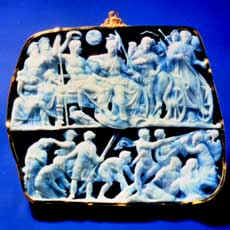| Select the jewel |
|
The History of Cameo: a Work of Art
|
|
|
Cameo-carving is one of the most striking activities of the artisan class in Italy. The boundary between its handicraft and art is extremely slender and it is often surpassed bay these men who are really the heirs of a long artistic traditions built up along centuries by the "masters in cameo-carving" since the most remote ages. Indeed, if the cameo identifies itself today with minute works of carving on shells, its name has always meant every stone worked in rilief, and more exactly the works in which are used the different layers of semiprecious stones for the differentation of the colors in the various plans of the relief itself. Even the word "CAMEO" appeared only in the XII century, this kind of jewel was greatly appreciated in the Hellenic age. In the epoch were used the semi-precios stones sardonyx and cornelian, much prized particularly for the different shades of color that the artist could make the most of in suggestive contrast: white, yellow, brown and reddish. For instance, the famous "Tazza Farnese" is a cameo, the masterpiece of the Alexandrian art; it belonged to Lorenzo the Magnificent and is actually kept in the National Museum in Naples. |
|
|
During the Roman age, cameo-carving became still more refined, accurete and elegant, for it found a fertile field in the Emperor's Court. Augustus brought in Rome, from the East, Dioscurides, whose masterpiece, the "Gemma Augustea" is in the Museum of Vienna.
|
 |
|
From the V to the XIII century this art marked a standstill; it flourished again in the Italian Renaissance. In Naples, at Ferdinand of Aragon's Court, lived the most famous cameo-carvers, Andrea di Mosnago and Battista Taglia; to the second was entrusted, in 1488, the care of engraving the royal seal in this quality of "master in cameo-carving". Great splendour had the cameo in the XVI century, during which Italian artists were called to serve the greatest Europeanmonarchs: from Valerio Belli to Giovanni Bernardi, to Alessandro Cesati, called the "grechetto". Nowadays, cameo-carving is no longer performed on semi-precious stones, but on sea-shells and the center of this industry is at Torre del Greco, at the foot of Vesuvious, where hundreds of artists and craftmen work following the schemes transmitted by their ancestor. Regarding the ancient tradition, the only change is in the choice of the raw material: also the cameo carved from a sea shell is a very fine high-relief; the technique is identical: the white or yellowish crust of special sea-shells (Cassis Madagascansarensis, Cassis Rufa, Cyprea Tigris, etc.) is cut so as to draw out faces, figures, mythological scenes, landscapes and flowers, in relief on the red-brown, black and white or differently colored background of the shell. Some pieces, actually not for sale, are priceless and are part of great private or public collectoins. At the end of the work, a very small part of the shell has been used, for the master carver has selected and studied attentively thickness and tonality, superimposition of the different layers, depth of the perspectives, shades and every possible effect of transparency. All this is done on a thickness one one or two millimeters, that the artist has, working only with a steel point, transformed in a real carved miniature, a work of art. The shell and coral carving center of CASCO s.r.l. uses a method thousands of years old. The use of steel gravers with handles, fitting the hand, are used in a timeless tradition of master craftsmanship. The master carver will select the shell to be used, outline the number of cameos to be obtained from that shell, and then supervise the entire carving process. With these incredibly sharp precision tools, the most intricate details can be obtained. This explains why cameos have turned out to be such an "INVESTMENT" to be handed down from generation to generation. No matter what profile or scene you choose,it is sure to be an "INVESTMENT" that will be cherished. Cameo jewelry is not only an investment for the purchaser but a gift for the next generation!
|
|